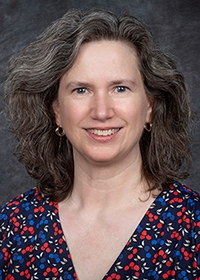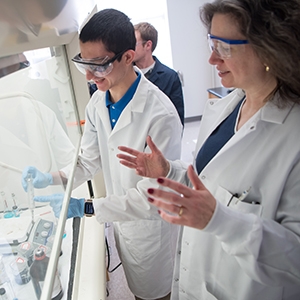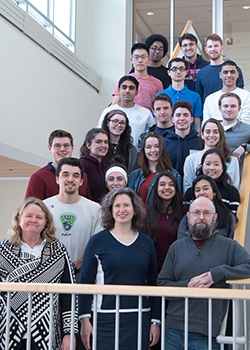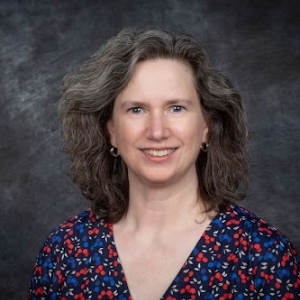Mary Carroll ’86 has always worn a lot of hats in service to her students, the College and her profession.
Her newest hat – president elect of the American Chemical Society – tops them all..
Carroll begins a three-year transition to lead the world’s largest scientific organization with more than 173,000 members and associates.
“It’s a huge honor to be elected to this position,” she said. “It was an honor to be asked to run, frankly.”
Carroll, the Dwane W. Crichton Professor of Chemistry, has been active with the ACS since 1992. She served as a councilor of the Eastern New York section for 25 years. At the national level, she served on several committees, most recently the ACS Committee on Science. She was recognized as an ACS Fellow in 2016.
This year, she serves as president elect. She will serve as president in 2024, and past president in 2025.
“I have a fabulous department here with fabulous students, and I really like working with my colleagues across campus,” she said. “But every time I go to an ACS event, I’m working with other professionals from academe, industry and government labs, and I always learn something.”
“As a professional, it’s really important to engage with professional societies,” she emphasized. “There’s a lot of benefit to having those interactions, but also to have your expertise help move things forward. I’m seeing things ripple down from that. You have the satisfaction of realizing that you’ve contributed to something.
On campus, Carroll has served as department chair and chair of the Faculty Executive Committee. She has been a member of the College’s Planning & Priorities Committee.
Among Carroll’s honors, she was named among 100 Inspiring Women in STEM by INSIGHT into Diversity magazine. She received the Outstanding Service Award from the New York Section of the Society for Applied Spectroscopy. From the College, she has received the Stillman Prize for Excellence in Teaching and the Stillman Prize for Faculty Excellence in Research (the latter with her colleague, Ann Anderson).
A video interview with Prof. Carroll is on YouTube.
ACS priorities
ACS is dedicated to building public trust in science.
“Science isn’t faith,” Carroll said. “It’s a process for learning about the world and moving forward. Sometimes, you end up with new evidence that changes your mind. That’s not a flip flop. That’s how science actually works.
“At this difficult time, it is critically important that scientists contribute to society as a whole via research, education, advocacy and outreach activities.”
Coming to Union
If going to Union wasn’t inevitable for the promising student from Spencerport, a suburb of Rochester, N.Y., it was a strong possibility. Carroll’s father, James ’61 (now deceased), was an optical engineer for Eastman Kodak.
Carroll considered a number of colleges, but she chose Union for its reputation as a liberal arts school with strong science and engineering. And Union’s financial aid offer appealed to a family sending the first of six daughters to college. When she arrived on campus, she was an undeclared major leaning toward a career in environmental law.
She took a range of courses in the liberal arts but eventually found her way to a chemistry major. “Doing chemistry was very engaging. The opportunity to explore and do things that hadn’t been done before was interesting,” she recalled.
Undergraduate research with Les Hull and Tom Werner helped confirm her decision to pursue chemistry. She spent her spare time focused on the performing arts, singing with Union’s Women’s Glee Club and as one of the founding members of Union’s first a capella women’s group.
At Union, she also met her husband, Michael Mahony ’85. Their daughters, Anna and Emma, graduated in 2020 and 2021, respectively. “We pretended they were away at school and agreed we would not pop in on them,” Carroll said. “It was great to sit back and watch them go through it in their own way.” Carroll’s late sister, Roberta (“Bobbi”) Carroll McCaffery, graduated in 1991.
After Union, Carroll entered Indiana University for graduate work in analytical chemistry, planning on an eventual career as an environmental lawyer. But the enjoyment she discovered as a teaching assistant led her to academe. And her alma mater.
Joining Union’s faculty
In 1992, after a Ph.D. at IU and a post-doctorate at UMass Amherst, Carroll re-joined the College to teach classes in general and analytical chemistry and engage in research. She was the first alumna hired to a tenure-track position on the faculty.
She quickly adjusted to calling her former chemistry professors by their first names, and she had some amusing interactions with faculty members from other departments who assumed she was visiting campus, rather than working at Union. Her initial research agenda focused on development of analytical instrumentation for molecular spectroscopy. She earned tenure in 1998 and was promoted to full professor in 2005.
Aerogel Lab
Silica aerogels have the same chemical composition as glass, but in a different form. Their low density (more than 20 times less than glass) and high surface area (550 square meters per gram) make them ideal as thermal, electrical and acoustic insulators.
In 2001, student Ben Gauthier approached Professor Ann Anderson, the Agnes S. MacDonald Professor of Mechanical Engineering, with the idea of making an aerogel for his senior thesis. Anderson teamed up with Carroll, who had worked with sol-gel materials as chemical sensors, to help Gauthier with his prototype.
So began Union’s Aerogel Lab, a cross-disciplinary program with students and faculty from chemistry, mechanical engineering and other STEM fields. Since 2001, 170 students have come through the Aerogel Lab. About half have gone on to higher degrees, and 40 percent have gone directly into STEM fields, Carroll said.
Carroll and Anderson have received two patents for an aerogel manufacturing method they have developed at Union. They also founded SunThru, a company developing aerogels for window insulation, which has former Aerogel Lab students John Costa ’17 and Adam Forti ’17 as CEO and COO, respectively. They are working with collaborators at the University of Perugia (Italy) on aerogel applications for windows. Brad Bruno, professor of mechanical engineering, has been working with Carroll, Anderson and students in the lab since 2010 on the development of aerogel alternatives to catalytic converters for the auto industry.
Carroll and Anderson recently published an article on the Aerogel Lab in Journal of Sol-Gel Science and Technology.
Speaking the language
Chemists and mechanical engineers don’t always speak the same language, Carroll notes. A chemist’s probe operates at a molecular level, an ME’s is hand held. The phrase “high temperature” has a different meaning in each field.
But there is tremendous value in sharing ideas from each field. “One of the things I really like is when students get together to present what they’ve been working on and other students can give them ideas,” Carroll said. “There is a richness in bringing people together from different fields and backgrounds to work on a project.”
The importance of presenting
Throughout her career, Carroll has encouraged students to present their work in class, on campus and at regional and national conferences.
“Very few people will be in a career where they don’t have to present their ideas or a product,” she said. “Having venues to present work that a student owns is really important. I saw in grad school that students who came from a liberal arts background were well equipped in terms of communication: writing, speaking and presenting ideas in formal and informal ways.”
Union’s history with the ACS
Carroll is the second member of the Union faculty to lead the American Chemical Society. Charles Chandler began at Union in 1856 in the dual role of assistant professor of analytical chemistry and janitor. He went on to a faculty appointment at Columbia University, where he was a leader in New York City public health initiatives and an influential founder of the ACS.
“I’m an analytical chemist here at Union, where we’ve had analytical chemistry for more than 165 years,” Carroll said. “It’s really fun to be part of that trajectory.”



